The Toyota Camry XV40 is the most popular and well-known generation for EU buyers. The car sold very well, which is why the manufacturer even organised an assembly plant in EU. It is that car, originally cheaper than the Germans of the business class, while keeping up with them in level, and now in the secondary market it is more expensive.
The model came out in 2006 at the Detroit Motor Show and immediately won the love of buyers. The reason is the brand's reputation as a simple technical car, which promises cheap maintenance and high reliability. It is the reliability and unrelenting demand that keeps the price of the car 30% higher than its classmates.
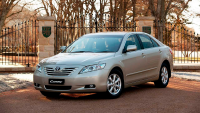
In 2009, the sedan underwent a restyling, changing the exterior slightly with technical shortcomings. In 2011 production closed with a run of over 100,000 cars in EU alone. The car was replaced by the seventh generation XV50.
Simple, austere styling
Toyota Camry XV40 sidewall
The design of the car looks simple, Toyota has never been an innovator in the field of looks, competitors are prettier. Here the headlamps are narrow, pointed downwards, fitted with halogen or xenon bulbs. Rounded forms of Camry's bonnet with lines are directed to severe radiator grill, in restyling it is covered with chrome.
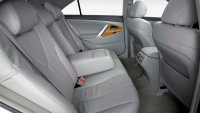
The bumper is equipped with headlight washers and recessed below fog lamps. The restyling brings a slightly different bumper with chrome-rimmed headlamps.
The side has a powerful, massive shape with slightly swollen arches. The business class image is supported by the chrome window surrounds and a flat line tending towards the tail lamps. The rear lights are identical in shape to the front. The boot lid has a raised shape, creating, together with the massive bumper, a powerful image.
Rear of the Toyota Camry XV40
It is the design focus on austerity that appealed to the officials, who are the main consumers of the model. The car looks simple while being relatively luxurious.
The dimensions of the sedan have gone up:
length - 4,815 mm;
width - 1820 mm;
height - 1480 mm;
wheelbase - 2775 mm;
ground clearance - 160 mm.
Bodywork Reliability
Paintwork here is weak, after a while there are small swells, scratches and chips. The front part is more exposed to it, but there is a solution - the use of armored film. The paint on door handles rubs off, and just gradually becomes muddy.
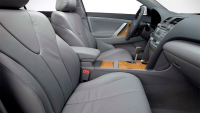
Rusting of Camry XV40 is a rare phenomenon, usually found on the edges of wheel arches of Moscow cars. More rust affects the undersides of the subframe, near the front spar and in the engine compartment.
Corrosion on the underside of the forty-fourth Camry
These are the main more or less serious flaws, which, against the competition, imposes the notion of ruggedness. Everything else is the usual little things that occur in some cars. The lip of the pre-styling cars often breaks off against kerbs or snowdrifts. Reinforcing doesn't help much, the best solution is to install an expensive restyling bumper.
The soft windscreen rubs off with age and the headlamps become cloudy. Headlights are more prone to reflector burnout than clouding. The Toyota Camry XV40 windscreen drain clogs reluctantly, it takes effort to clog it. In winter, doors can freeze up - a normal phenomenon, though you shouldn't jerk the handle too much. Scattered winter reagents also affect chrome-plated decorative linings.
Be careful at the petrol station. The metal behind the petrol tank hatch is thin; there have even been cases of a hole being punched with a petrol gun.
Spacious interior comfort
Interior of the sixth Toyota Camry
There's plenty of space inside, with passengers seated in cool, upholstered leather seats. The front row is electrically adjustable in good configurations and there is heating. The back can also be heated, and the top specs even have 8 degrees of backrest tilt adjustment.
Inside, there are all the most necessary things, from multimedia screen supporting navigation to separate climate control. There is no sense to stop on an equipment, it is better to describe a complete set separately.
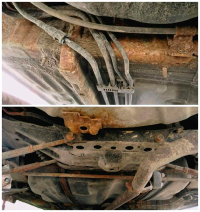
Front seats of the Camry XV40Rear seats of the Toyota Camry XV40
Generally, leather is used as upholstery, but the manufacturer didn't skimp on plastic details, and added wooden elements for decoration. Leather upholstery of Toyota Camry XV40 after 150 thousand actively starts to lose its marketable appearance. Tears are rare, but cracks and serious wear and tear are frequent. Electric adjustment of seats works perfectly, sometimes wiring fails.
Camry 40's dashboard
The plastic elements, including the back of the steering wheel, start to make squeaks over time. It's better to make, what's the sense from good noise isolation, if there is another, internal source of a sound. By the way, noise isolation in a field of 200 thousand is not so cool, because the gaskets are worn out. Decorative wooden inserts do not stand the climate, losing external lacquer.
In addition to the squeaky plastic steering column, frequent sharp turns interrupt the wiring, causing the steering wheel buttons to malfunction. Toyota had a recall campaign to replace the power windows - there were problems, and they also changed the mats, as the driver's one could jam the accelerator pedal.
Camry XV40 boot photo
Camry XV40 options
Dealers have sold the car in 5 different kits, but in restyling the names have changed a little. The basic package Comfort is already well-equipped:
16-inch wheels;
halogen optics;
fog lights;
rain and light sensors;
leather multi steering wheel;
cloth upholstery;
heated seats;
6 airbags;
front and rear parking sensors;
2-zone climate control.
The top-of-the-range Luxe package is much more interesting; it is the one the officials bought:
xenon optics;
headlight washers;
an engine-start button;
leather interior trim;
electric seat adjustment;
keyless entry;
rear sofa adjustment;
cruise control;
navigation system
reversing camera.
Which engine - specifications
Type Volume Power Torque Acceleration Top speed Number of cylinders
Petrol 2.4L 167hp 224 H*m 9.1 sec. 210 km/h 4
Gasoline 3.5L 277 hp 346 H*m 6.8 sec. 230 km/h V6
Read more at
The engine range consists of two technically simple, reliable, petrol engines.
2.4 2AZ-FE
Photo of the 2AZ-FE engine.
The base engine is 2.4 litre 2AZ-FE from its predecessor with VVT-i system. Atmospheric engine produces 167 horsepower and 224 units of torque. It is quite enough for a dynamic drive but the consumption is a bit high - 14 litres.
A sore of the engine is in weak crankcase ventilation system, which overflows Toyota Camry XV40, intake and throttle valve with oil. After 200k km, it is necessary to check all seals, as soon the same oil will start flowing out through them and oil pressure sensor.
There are no hydro-compensators, so every 120 thousand you need to adjust the valves. The chain drive of timing chain lives over 150 thousand, and some have the same life as a piston, which goes longer than 350 thousand kilometres. The problem is with weak tensioner, pump and catalytic converter, which are better to cut or watch for ringing. Don't overheat the motor to avoid damaging the cylinder block threads.
3.5 2GR-FE
2GR-FE engine
This is an atmospheric 3.5-liter V6, producing 277 horsepower and 346 H*m of torque. The engine gives great dynamics and the consumption is slightly higher - 14 litres according to the passport. There is a double VVT-i system.
There are similar problems, but the main fault is the rapid wear of the chain, which is already stretched to 120 thousand miles. The clearances need to be adjusted more often, and the pump needs to be replaced more often. When the Camry's engine starts making noises, the cause is pressure leaking from the VVT-i phase shifters. Racers have to clean the throttle more often to avoid floating idle.
Before 2010, a metal-plastic oil supply tube was put in, which liked to burst and deprive the engine of oil in 15 minutes completely. In recalls and owners who didn't pass them, the tube was replaced with an all-metal tube.
Restyled Toyota Camry XV40
More racers load cylinders, and cooling system can't cope and as a result there are scuffs. Good thing boring of cast-iron liners is not so expensive. In general, it is better to refuse from 3,5-liter engine, as it loads a suspension with its weight besides the listed ailments.
Transmissions .
The engines were paired either with 6-speed manual E351 or automatic transmission Aisin. The 2.4-liter engine received a 5-speed U250E/U151E, and the V6 was equipped with a 6-speed U660E. In terms of reliability, the transmissions have proved to be decent.
The manuals are traditionally survivable, but nothing lasts forever. With the age a rocker is worn out and a backlash appears. "Professionals" managed to tear drive cables of sixth Camry or to bend a lever. After 150k, it is necessary to change clutch, and it's better to change cables in order not to loose couplings.
Aisin U250E automatic transmission
A 5-speed automatic has 300 thousand km range, and in some cases half a million km, especially if the gearbox is not strained by races and timely oil and filters are changed. Racers stressing it kill solenoids of hydroblock, and then the bushing, oil seals, etc. get worn out. Often racers encounter burnt friction in Overdrive before the bearing dies, which promises hard engagement of the reverse gear.
There are problems with lever functionality - it just won't work. These are electrical 'shoals' associated with the throttle pedal sensor and the parking motor.
Aisin U660E automatic transmission
The 6-speed transmission is more complex by design. Its problem is the fast wear and tear of the throttle lock and the throttle body itself, which contributes to clogged channels of the hydroblock and oil leakage. Ill spots include the plate, solenoids etc., but as a whole, the mechanism will hardly last more than 200 thousand kilometres, if the owner has not confused Japanese with Italians. In the restyle, modified 6-speed has lost a part of problems, but it was not possible to cure it completely.
The transmission components of the Toyota Camry XV40 include CV joints, which are replaced along with the half axle at around 100,000 kilometres.
Suspension, braking system and steering
Toyota Camry XV40 with girls
The suspension remains the same as last with McPherson struts all round and anti-roll bar stabilisers. The steering is here with GUR and the disc braking system is complemented by all the electronic assistants.
The suspension is a model of reliability, which up to 100,000 km requires no attention other than replacement of the anti-roll bars. After 50,000km the ball joints need replacing and the strut supports and shock absorbers need replacing to retain the same comfort. Bad rubber kills the rear hub bearings.
Steering is reliable, only leaks with knocking occur at high mileage. The knocking is due to a worn splined joint between the rack and the cardan cross. Sometimes the steering position sensor fails, which disables ESP.
Photo of a black Camry 40
The braking system with the 2.4-liter engine is reliable. Discs survive three pad replacements, and some manage to have native discs at 200 thousand miles. Owners need to constantly lubricate the caliper pins to keep them from seizing up. The Camry XV40's 3.5L engine weights the discs much quicker and there is a rumor that the brakes are unreliable.
The handbrake, or more accurately the stay-put, quickly loses its grip due to cable looseness. Replacing or tightening the cables is tricky, because you have to remove a lot of plastic parts to get to it.
Electrics
There are plenty of problems here. The overrunning clutch has badly damaged the reputation of the car, living not more than 100 thousand. It causes unnecessary sounds and run-off of an accessory belt. The alternator brushes live 150,000 km.
The wiring is holding up exemplary, it doesn't rot and only the boot lid harness gets frayed. Of course, remember the immobiliser issues.
Toyota Camry 6 sedan stern
Ex-owners of stolen sedans complain about open ECU. It's swapped out for another one and away they go. Keys are also easily stitched to the model, so removing the diagnostic connector and protecting the bonnet is recommended. It's a matter of two minutes to steal a forty.
Price of the 40th Camry
High sales have supplied the market with a huge number of cars, most of them with a "proper" 2.4-liter engine. Cars are sold for 1000 USD, and as you understand the price tag here is a clear indicator of condition. Mileages are often swiped, therefore it is useless to advise to look for models with run less than 200 thousand kilometres.
Maintenance of a Japanese is much cheaper in comparison with the Germans, here are prices of some original spare parts:
The attentive reader will be indignant at the list of faults and the concept "reliable". In reality, all the ills don't appear on one car, and compared to the German competitors it really is forever. The only thing where the Toyota Camry XV40 loses out to the Germans is the level of business comfort.
Check everything when you inspect it and don't shun corporate cars, they are often well serviced. We recommend taking the 2.4 litre motor, and if you're prepared for V6 soreness and tax, go for it.
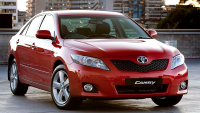

-rear-and-front-view-camera-6.png)

